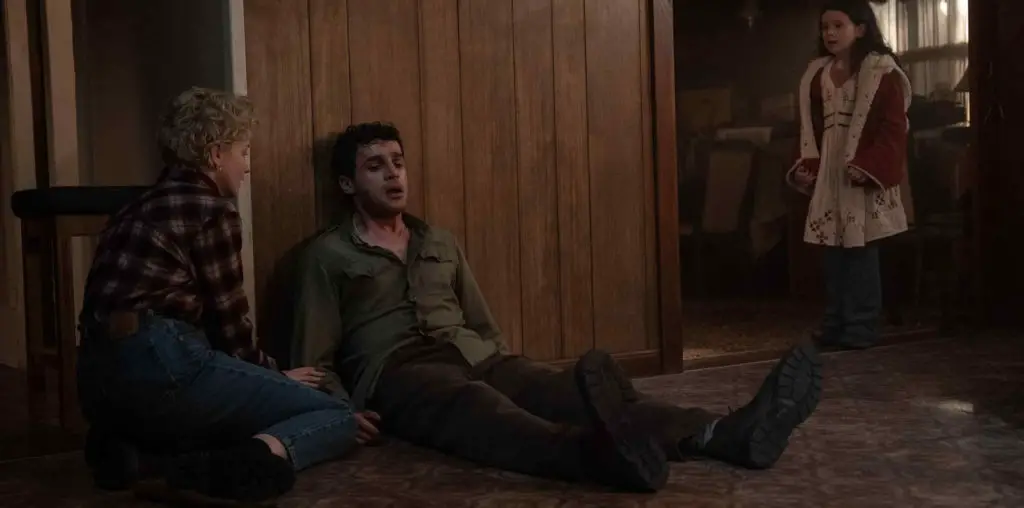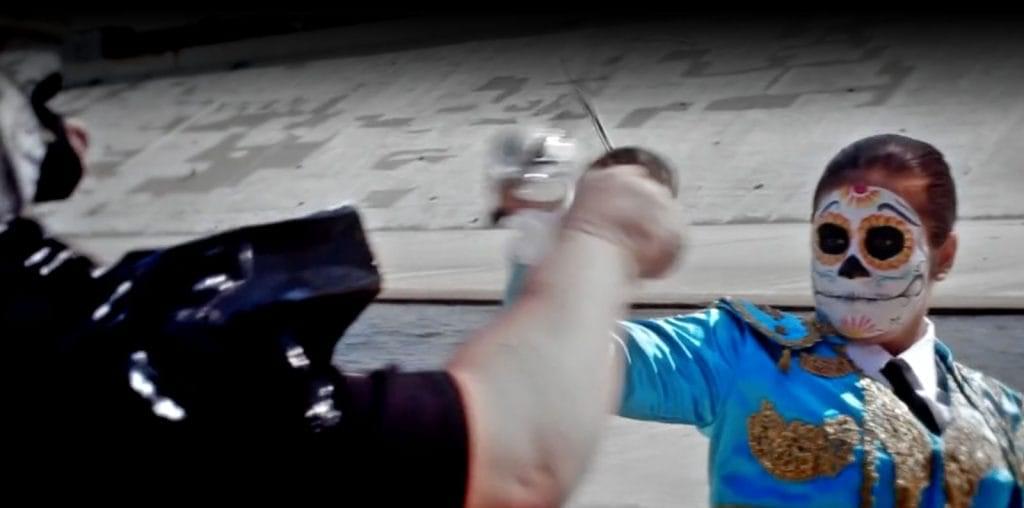
Obsolescence Minded
One additional limitation to William Gibson’s version of contemporary fiction is that it quickly becomes outdated. The type technology that he chooses to involve himself with evolves at a quick pace, with hardware and software becoming outmoded in scant few years, so that Gibson’s tales are as relevant today as a Commodore-64. The crux of “Johnny Mnemonic” is that he is an information courier, implanting data in his head to be delivered across the globe. There has to be numerous options more reliable—cable modems, fiber optics, satellites, carrier pigeons—than entrusting valuable intelligence to a slack-jawed grunt from Simi Beach.
The real surprise is that for all the promise of futuristic themes Gibby delivers a script with plot elements that were old when the Edsel was on showroom floors. For openers, we get a crawling text of a prologue to shorthand the backstory before we meet Mr. Mnemonic as he wakes up next to a hooker in his hotel. This is not a wise fella, as we soon get lectured that one half of the planet is infected with the NAS virus—Nerve Attenuation Syndrome—which results from humanity’s over reliance on technology. It is one of the few elements in the plot that sounds compelling, the possibility of humans contracting computer viruses. But things turn pedestrian fast. Johnny, we learn, is ready to make “one last run” before getting out of the game and reclaiming his childhood memories. They were jettisoned to make room for more storage, but judging by Keanu’s delivery there was already plenty of space in his brain pan. In the Orient he meets the clients who pay for him to make a delivery to New Jersey and he takes on double his loadable capacity, which means he runs the risk of neuron damage and death from seepage if he doesn’t download the data in a timely fashion.
Next scene we get the familiar count-down plot device as he is told he has 24 hours before permanent damage results. This is a landmark occasion for the viewer: It marks the first time in the career of Keanu Reeves that he was found to have too much going on in his brain. As he uploads his cargo data with a “Matrix”-like jack in the back of his head the first wave of bad guys arrive and the chase begins. As Johnny slips the murderers the randomly generated access code for his data is partially destroyed by the thugs. We aren’t clear who they are because Johnny has no clue what is in his head, but soon we come to learn there is a major pharmaceutical corporation interested in stopping the delivery. Another common device is the stark division of a nefarious corporate power and the noble street urchins fighting against those in power. Here they call themselves the Lo-Teks and they are led by J-Bone, played by Ice-T who walks around with a Patti LaBelle mane.
Among these street denizens we meet Jane, a feisty lass who has dreams of becoming a bodyguard, one career in the future that doesn’t seem to have glass ceiling problems. (I guess the Lo-Teks don’t have debutante balls.) Jane however has trouble breaking into her field because she is being treated for NAS by her friend Spider (Henry Rollins) who is an underground cyber rat helping the resistance; sort of the Lo-Teks’ high-tech expert. Johnny makes it back to the States and looks up his agent Ralfi (played by Udo Kier, whom I have never trusted) to get help removing the damaging data. Ralfi instead sells out his charge and gets him strapped down on a table to have his head removed by a back alley medic.
Right before Keanu loses his dome, Jane, ever the self-starter, drops in from an air vent to halt the ad-hoc surgery and strikes a business deal with Mnemonic to become his guardian. This becomes less of a comfort a short time later when Jane’s NAS condition flares up and she becomes momentarily immobilized by visual seizures. Johnny acts indignant that she has this affliction even though he repeatedly undergoes almost identical episodes from his cranial overload. The pair limp their way to Spider’s lair where he treats Jane and tries tapping into Johnny’s head, where he discovers he’s carrying the cure to NAS. More attempts on his life ensue, including a street corner preacher who is also an assassin for hire. This minister of pain from a depraved arch-diocese is played by Dolph Lundgren, in what has to be his only role to date with dimension. That is not to say he is good in said role.
Our afflicted pair limps their way to Jersey where they come under the care of the Lo-Teks who have just the answer to helping Johnny hack into his own brain and purge the payload—a porpoise. Apparently, the highly evolved brain of the water creature, and a full compliment of technical gadgets welded to its head, will be exactly what is needed to download the cure to the disease. In Gibson’s original story the creature was also an addict, which means we could have had the delicious scene of Dolph Lundgren and drugged dolphin together. Dolph’s murderous minister shows up to take Johnny’s head from him, because he really wasn’t using it anyway, but then Jane and the dolphin team up and she aims a parabolic dish that allows the mammal to shoot sonar beams that cause the hirsute preacher to burst into flames.
Johnny now manages to drain his head and collect his childhood memories as a bonus. And of course he and the girl hook up, to everyone’s surprise. The unintentional irony in all of this is that Gibson managed to adapt his cutting edge work in such a half-hearted (or half-assed) manner that he employed countless cliché’s resulting in a film that—despite the title—is hopelessly unmemorable. It took repeated viewings for me to glean enough material for this column. One scene alone stands out. Keanu looks someone dead in the eye and proclaims, “I’ve got this problem,” and then taps his head—“Up here.” It may be a testament to Reeves learning the acting craft that he didn’t bust out laughing as he delivered that line. As for me, I was on the floor, turning blue with chortles.
____________________________________________________________
Brad Slager brings us a deep exploration into films that received a major studio release, with bankable star talent and a significant promotional campaign, and yet failed to receive the public’s attention. Brad trains his focus on those titles that have failed to register in the public conciousness–even for those who have seen them–and strives to find out what caused the problems, although he occasionally may digress into unrestrained flagellation. (For this we apologize.)
Got your own opinion? Tell everyone in Film Threat’s BACK TALK section! Click here>>>

